First of a series of articles in which we answer frequently asked questions. In this article: What is the difference between a flat and sharp note?
When you have been using Sonid for a while, you have probably come across more complex subjects you don't fully understand the first time you read about them. To help you further in your quest of mastering music, we are writing a serie of articles in which we answer some of the basic topics that might seem difficult.
One of the questions we most often get is What is the difference between a flat and a sharp note?
To answer, we must dive into the world of flats and sharps.
When you have been learning scales on your instrument there's a good chance that someday you want to transpose the C major scale you've learned to play F major. When doing so, you'll soon find that some of the notes in F major will need a flat or a sharp to keep the structure of a major scale. At first, you may come up with writing the notes for F major as: F G A A# C D E. (Note that the natural A is used for A and A sharp.) But advancing further into more complex scales or keys this method doesn't seem to work any longer and you find yourself in an "accident" nightmare.
So why can't you use A and A sharp in the same scale? Aren't they the same note? They sound the same, that's for sure. So practically, yes they are the same. And, when talking about a note without context, you can certainly name it to your pleasing. But when the approach becomes more theoretical and with context? No. A flatted note is not the same as the equivalent sharped note. B sharp is not the same as C and Gb is not the same as F#.
Sharps and flats might scare you a bit, resulting in avoiding them. When you see a music piece with a lot of sharps or flats, it probably seems hard and complicated. Maybe you are not so keen to get into the subject, but once you know the basics, it will get a lot easier!
When you look at the piano you will see white and black keys. The white keys are the naturals. The natural tones represent the seven tones within an octave. We name them C, D, E, F, G, A and B. This is easily seen in the scale of C-major, the scale without sharps and flats.
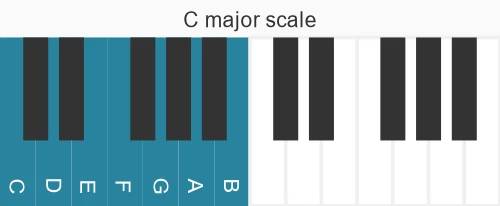
Now, again, take a look at the black keys on the piano. The black keys on a piano represent the flat and sharp notes.
Sharp notes are raised by a semitone, meaning a half step. The symbol for a sharp is #. Examples of sharp notes are F#, C#, D# and G#.
Notes with a flat are lowered by a semitone. The symbol for a flat is b. A few examples of flat notes are Bb, Eb and Ab.
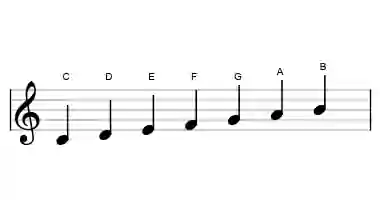
Maybe you have noticed the absence of a black key between the notes E and F, and B and C. This is because the distance between E and F, and B and C, consists of only one semitone. So, when you play E#, it will sound the same as F. And when you play Cb, it will seem as though you are playing B. Seems complicated, right?
In music there is a name for this: enharmonic equivalence. Every tone can be written in two ways, which sound the same. When you play a D#, you can name this tone either D-sharp or E-flat, and a C# can be named C# or Db. This makes the subject a bit harder, because you have to know when you should use which name for a tone.
Now you have learned the basics about raising and lowering a tone. To understand why and when we write a flat or a sharp, we can take a look at the composition of the major scale. First we look at C-major, the major scale with no flats and sharps.
Every major scale consists of the same intervals. Between the third and fourth note, and between the seventh and eighth note there is one semitone distance. Between all other notes there is a whole tone distance. Take a look at C-major:

As you know, between E and F is one semitone distance, and the same goes for B and C. With this knowledge we can calculate which notes are in, for example, a F-major scale.
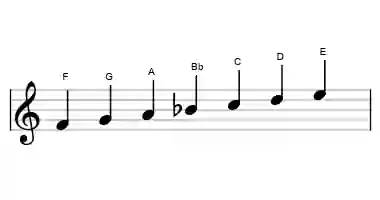

F-major has, as you can see, one flat. So why do we write Bb!? You could also play an A#, because it would still sound the same. But you can never write an A# in the F-major scale, because it will result in two A's being present. According to the rules of music every natural should be used once, and now we are missing the B.
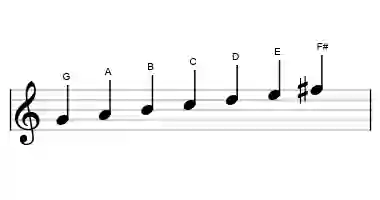
This logic goes for every scale. For example: we can take a look at the G-major scale above. The G-major scale has one sharp, F-sharp. It would get pretty strange if you would write Gb instead! So, always make sure to include every natural.
Maybe you've heard about these strange symbols before. They are called the double sharp, or double flat. Basically, it is just a note with two sharps, or two flats. So a double sharp is raised by two semitones, and a double flat is lowered by two. This means a C## sounds like a D, and a Gbb sounds like a F.
You may wonder, when would I use this strange notation? It seems to make music notation even more complicated. One of the reason you would use a double sharp or double flat is because of the key you are playing in. To explain this, we can take a look at the G#major scale.
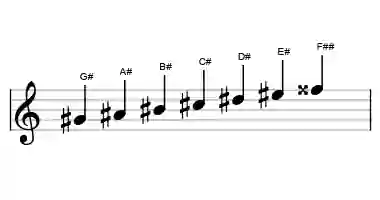
Remember, all seven naturals should be present in a scale. As you can see, G#major consists of G#, A#, B#, C#, D# and E# and F##. The last note is written as a double sharp, because there can not be two G's in a scale.
We began the article with the question "What is the difference between a flat and a sharp note?" First of all, the difference is that a flat lowers the tone and a sharp raises the tone. That would be too easy, right? Of course this is not the answer we are looking for!
The difference has nothing to do with the pitch of a tone, but all with the notation. You have to look at the context of the scale or interval you are playing, or remind yourself which key you are playing in. Then you will know if you should write a flat, sharp, or even a double flat or a double sharp.
First of a series of articles in which we answer frequently asked questions. In this article: What is the difference between a flat and sharp note?
First of a series of videos to explain music theory in small chunks of information. Today part 1 - Naturals.
A series of videos to explain music theory in small chunks of information. Today part 2 - Sharp
A series of videos to explain music theory in small chunks of information. Today Part 3 - Flat